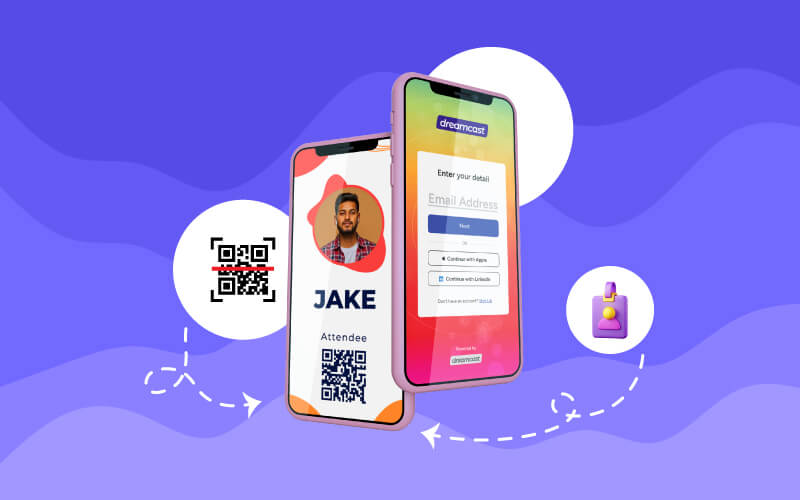When planning an in-person event, it’s important to monitor certain metrics that will set you up for an effective event. In-person event KIPs (Key Performance Indicators) enable event organizers to measure everything from event attendee retention to sponsor satisfaction scores. These KPIs are vital in ensuring the success of your event, as they provide valuable data on the experiences of attendees, sponsors, and exhibitors.
By tracking the right event KPIs for organizers you can give yourself the best chance to make data-driven decisions that will optimize every facet of the event and give you more successful outcomes, as well as a higher return on investment (ROI) overall. So in this blog, we delve into 11 important KPIs for in-person events that every organizer should be measuring for maximum event success.
Table of Contents
Understanding In-Person Event KPIs: What They Are and Why They Matter
In-person event KPIs refer to metrics that measure the success of the event in achieving its objectives. There are several different types of KPIs, from event attendee retention KPIs and registration conversion rate to total new attendees brought, each of which fulfills its role in assessing the effectiveness of some aspect of the event. If you intend to increase the engagement rate of an event or improve sponsor satisfaction scores, monitoring these KPIs ensures that you have some numerical figures to analyze how successful you have been, and what needs to be improved.

When it comes to event KPIs for organizers, it is crucial to choose the event KPIs that are most relevant to the event’s aims. For example, if networking and lead generation are the priorities for your event, monitoring event engagement rates and registration conversion rates will provide you insight into attendee participation and whether the event manages to convert interest into action.
How to Choose the Right KPIs for Your Event
Choosing the right in-person event KPIs is largely dependent on the goals of the event itself. If you are trying to keep an eye on event attendee retention KPIs, then you need to measure metrics like engagement levels, satisfaction, repeat attendance, etc. At events where the priority is to create the most significant value for sponsors, a fifth metric that should be added to the list is sponsor satisfaction scores, making it a key performance indicator (KPI).
So, for event KPIs for organizers, it is important to take a mixture of both quantitative KPIs as well as Qualitative KPIs. Hard data such as quantitative KPIs, e.g., registration conversion rate or event engagement rate, can be balanced out against qualitative metrics such as post-event surveys that reveal attendee satisfaction levels and the impressions sponsors had of the event.
Key Considerations When Choosing The Right Event Kpis:
Set clear event goals with aligned KPIs.
Monitor engagement, satisfaction, and retention metrics for attendees.
Educate expectations and measure success via satisfaction scores and ROI analysis
Combine qualitative (e.g., post-event surveys) and quantitative (e.g., registration conversion rate) KPIs.
Use event performance and feedback to continuously improve KPIs.
11 Essential In-Person Event KPIs Every Organizer Should Track
Whether planning a corporate conference, an industry trade show, or a cultural festival, knowing and measuring the right Key Performance Indicators (KPIs) can help ensure that your event is not just held but also has a measurable effect.

Let’s dive into the metrics that matter most:
Event Attendance Numbers
Total Event Attendance=Number of Check-Ins+On-Site Registrations
Attendance is among the most basic in-person event KPIs, so you need to measure it. It Gives You a Clear Sense of the Early Interest in Your Event The second statistic compares registration conversion rate with attendance to determine how persuasive your promotional methods and registration process were. A low registration conversion rate may suggest that attendees aren’t fully engaged or there are barriers in your registration process.
Registration vs. Attendance Rate
Registration vs. Attendance Rate=(Total Registered Attendees/Total Attendees)×100
It is vital to understand how many registered attendees attend. The registration conversion rate is the percentage of people who registered for your event but ended up attending it. A higher attendance rate indicates successful engagement and interest in the event. This might show that your attendees are engaged with you, which generally goes hand in hand with a high event attendee retention KPI rate in upcoming events.
Audience Engagement Metrics
Session Participation Rate=(Total Registered/AttendeesTotal Session Attendees)×100
Poll Engagement Rate=(Total Attendees/Total Poll Responses)×100
Event engagement rate is the most valuable in-person event KPI to track. Engagement is a crucial measure of interest among attendees, and high levels of engagement generally mean that an event was a success. Measures how long participants spent watching a session, indicating whether or not they paid attention. Low session viewing times indicate a need to improve engagement tactics. Whether it’s gauging attendance in sessions or audience engagement during live Q&As, the behavior’s statistics give an idea of audience engagement. This has a direct effect on event attendee retention KPIs, as the higher the engagement, the better the retention for future events.
Networking Activity
Connection Engagement Rate = Total Number of Networking Interactions/Total Number of Attendees× 100
In-person gatherings often prioritize networking opportunities. Networking activities, such as the number of meetings attended or the number of relationships established. A measure of what you have done to help people meet other people that can lead to meaningful interactions. By monitoring the event engagement rate as it relates to networking sessions, and how many attendees engage with each other, you can gauge how successful the event is at relationship-building.
Event App Usage
App Engagement Rate=(Total Attendees/Total Active App Users)×100
Most events that have a custom event app need to know how often attendees regularly open it. When it comes to event KPIs for organizers, you also have things like app downloads and feature usage or interactions. Event solutions like session bookings and live pollings help boost the engagement rate of the event which can consequently influence your event success. Monitoring the response rate to live polls assesses how actively participants are involved and which sessions resonated most.
Social Media Mentions & Hashtags
Social Engagement Rate=(Total Interactions (likes, shares, comments)/Total Event Mentions)×100
Tracking social media mentions, hashtags, and shares is another key in-person event KPI that should be monitored. Keeping track of number of mentions by attendees for your event is a good indicator of reach online in presence of audience and also public perception about the event. A high amount of social media interaction usually results in higher event engagement rates and spikes in interest in future events.

Speaker & Session Ratings
Average Rating=Number of Responses/Sum of Ratings
Most importantly, speaker and session feedback. Measuring the quality of the session and speakers — that’s actionable data you can use to improve your next event. This is an important part of the event KPIs for organizers, tracking these ratings allows you to understand how to keep improving your event and boost your event attendee retention KPIs.
Lead Generation & Conversion Rates
Lead Generation Rate=(Total Number of Attendees/Number of Leads Captured)×100
Conversion Rate=(Number of Leads Captured/Number of Conversions)×100
When it comes to sales and business development events, monitoring lead generation and conversion is essential. Combining the registration conversion rate with some post-event follow-up data enables you to understand how well the event worked at capturing leads, and whether those leads converted to revenue-generating business relationships. This will also show how successful the event was in meeting business targets.
Sponsor and Exhibitor Satisfaction
Average Satisfaction Score=∑All Satisfaction Scores/Total Number of Respondents
Sponsors play an important role in many in-person events, and their satisfaction is critical to an event’s success. Understanding sponsor satisfaction scores will give insight into ROI and the intention to return to future events. When sponsors feel their contributions are respected, they tend to be more supportive of the funding of similar events in the future and help with promotions.
Revenue and Ticket Sales
A tangible measurement of financial success is revenue from ticket sales and other sources. Conventional event KPIs such as tracking how revenue stacks up against expectations and costs are part and parcel for organizers. It helps assess the financial health of your event as a whole, and whether you need to adjust pricing or your ticketing strategy.
Post-Event Feedback and Satisfaction
Survey Response Rate=(Total Attendees/Total Responses)×100
Another important aspect is the post-event surveys used after the event to measure attendee satisfaction. Getting feedback helps you understand what you did well and what you could improve. Using this feedback to help make adjustments to future events is a tangible way to address retention KPIs for attendees at future events, identifying areas to improve and items that will enhance the experience of attendees. Also, this data helps to improve engagement rates for future events.
Using In-Person Event KPIs to Improve Future Events
After you have gathered and analyzed your in-person event KPIs, the next thing to do is use the data to improve your future events. You can use this knowledge to increase event attendee retention KPIs, boost event engagement rates, and raise sponsor satisfaction scores; these insights help you refine your events to achieve even greater success in the future.
Event KPIs for organizers then you can learn from past events, adjust your strategy based on what worked and what didn’t, and aim to create a bigger impact. The KPIs of high event attendee retention are usually the result of continued enhancement on sound, actionable data.
Key Pointers To Improve Future Events:
Use past attendee engagement to improve content for the next event.
Leverage feedback to help adjust event timing, location, and format.
Monitor the satisfaction of sponsors and adjust your sponsorship offerings for future events.
Optimize the market proposition based on the statistics of attendee retention.
Leverage insights on the behavior of attendees to get your future event experience personalized.
Conclusion
Tracking the right in-person event KPIs is vital for improving the overall success of your events. Whether you’re focusing on event attendee retention KPIs, event engagement rates, or sponsor satisfaction scores, these metrics provide critical insights into attendee experience and event performance. By continuously analyzing these KPIs, event KPIs for organizers can lead to more effective event planning, resulting in higher satisfaction and better business outcomes.
By understanding and applying these KPIs, you’ll be well on your way to creating more engaging, impactful events in the future.
FAQ
Real-time tracking allows organizers to make immediate adjustments during the event. For example, if engagement levels drop, organizers can introduce interactive sessions or push notifications through the event app to boost participation.
Some of the best tools include event management software, mobile event apps, survey platforms, and CRM systems. These tools help collect data on attendance, engagement, and post-event feedback.
For large conferences, KPIs like session attendance, lead generation, and sponsor engagement are crucial, while for smaller networking events, tracking meaningful connections made and engagement in discussions is more relevant.
Yes, qualitative feedback from surveys, interviews, and attendee testimonials provides context to numerical data and helps understand the “why” behind attendee behavior.
By presenting data on attendee demographics, engagement levels, and sponsor visibility, organizers can demonstrate the ROI for sponsors and attract future partnerships.



















